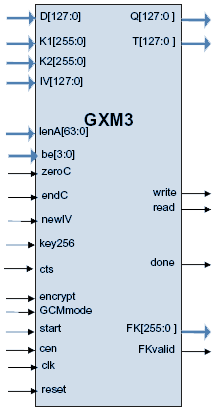|
|
 |
|
|
GXM3
P1619/802.1ae (MACSec) GCM/XEX/XTS-AES Core |
|
| |
General Description
LAN security standard IEEE 802.1ae (MACSec) uses AES cipher in the
GCM mode, while the disk/tape encryption standard IEEE P1619 uses
the XEX/XTS mode. Since GCM and XEX/XTS share some of their basic components,
a combo GCM/XEX/XTS core is not much larger than a dedicated core for
either of the modes.
The GXM3 core is tuned for mid-performance P1619 and 802.1ae applications
at the data rates of 2-3 Gbps and higher. The core contains the
base AES core AES1 and is available for immediate licensing.
The design is fully synchronous and available in both source and netlist
form.Symbol
 |
Key Features
|
Small size:
From 60K ASIC gates (at throughput of 18.2 bits per clock)
487 MHz frequency in 90 nm process
Easily parallelizable to achieve higher throughputs
Completely self-contained: does not require external memory.
Includes encryption, decryption, key expansion and data interface
Support for Galois Counter Mode Encryption and authentication
(GCM) and XTS-AES mode per P1619
XEX-AES encryption mode
Cipher Text Stealing (CTS) included
Flow-through design
Test bench provided |
Applications
- IEEE 802.1ae:
LAN switches, routers, NICs
- IEEE P1619: hard drive and tape encryption, SAN, NAS
|
|
| |
Pin Description
| Name |
Type |
Description |
| CLK |
Input |
Core clock signal |
| Reset |
Input |
Core reset signal (active HIGH) |
| Cen |
Input |
Synchronous enable signal. When LOW the core ignores all its
inputs and all its outputs must be ignored. |
| GCMmode |
Input |
When HIGH, GXM3 mode is GCM, when LOW mode is XEX |
|
Encrypt |
Input |
When HIGH, core is encrypting, when LOW core is decrypting |
| key256 |
Input |
When HIGH, 256 bit AES key is used, when LOW – 128 bit
AES key |
| endC |
Input |
(GCM mode only) Marks last data block |
| zeroC |
Input |
(GCM mode only) Marks the block with zero length of plaintext/ciphertext
field |
| newIV |
Input |
(XEX mode only) Marks the last block of the data unit if followed
immediately by the first block of the next data unit with different
IV. |
| cts |
Input |
(XEX mode only) Marks the last full 128-bit block of the data
unit in case that the next block of this data unit is less than
128 bit (CTS mode) |
| Start |
Input |
HIGH level starts the input data processing |
| Read |
Output |
Read request for the input data byte |
| Write |
Output |
Write signal for the output interface |
| D[127:0] |
Input |
Input Data (other data bus widths
are also available)
- For GCM, additional authenticated data (AAD, A), followed
by the plain or
cipher text
- For XEX, plain or cipher text
|
| K1[255:0] |
Input |
256 bit or 128 bit AES key (128-bit key uses K1[255:128] pins) |
| K2[255:0] |
Input |
(XEX mode only) Tweak key (K2) (128-bit key uses K2[255:128]
pins) |
| IV[127:0] |
Input |
(GCM mode only) Initial counter value (Y0, IV || 0311) |
| lenA[63:0] |
Input |
(GCM mode only) Length of additional authenticated data in
bits |
| be[3:0] |
Input |
Byte length of the last data block in bytes minus 1 |
| FK[255:0] |
Output |
256 bit or 128 bit final round key (128-bit key uses FK[255:128]
pins) |
| FKvalid |
Output |
HIGH when FK is valid |
| Q[127:0] |
Output |
Output plain or cipher text |
| T[127:0] |
Output |
(GCM mode only) Computed MAC (tag, T) |
| Done |
Output |
HIGH when data processing is completed |
|
|
| |
Function Description
The Advanced Encryption Standard (AES) algorithm
is a new NIST data encryption standard as defined in the http://csrc.nist.gov/publications/fips/fips197/fips-197.pdf
.
The GXM3 implementation fully supports the AES algorithm for 128 and
256 bit keys in Galois Counter Mode (GCM) as required by the 802.1ae
IEEE standard and in XEX mode as required by the IEEE P1619 standard.
The core is designed for flow-through operation, with input and output
interfaces of flexible width. GCM additional authentication data precede
the plaintext in the flow of data. GXM3 supports both encryption and
decryption modes. |
|
| |
Synthesis Results
Device Area Utilization
and PerformanceRepresentative area/resources figures are shown in the
table below.
| Technology |
Area / Resources
|
Max Frequency
|
Throughput |
| TSMC 0.13 µ LV |
70,543 gates |
207 MHz |
3.7 Gbps |
| TSMC 0.09 µ LV |
85,961 gates |
348 MHz |
6.3 Gbps |
| TSMC 0.09 µ LV |
119,493 gates |
487 MHz |
8.9 Gbps |
|
Core can be easily synthesized for higher throughputs with slightly
increased gate count. Few GXM3 cores can be easily paralleled to achieve
10 Gbps or higher throughput. |
|
| |
Export Permits
| US Bureau of Industry and Security has assigned
the export control classification number 5E002 to our AES
core. The core is eligible for the license exception ENC
under section 740.17(A) and (B)(1) of the export
administration regulations. See the
licensing basics page,
for links to US government sites and more details. |
|
|
| |
Deliverables
HDL Source Licenses
- Synthesizable Verilog RTL source code
- Verilog testbench (self-checking)
- Vectors for testbench
- Expected results
- User Documentation
|
|
Netlist Licenses
- Post-synthesis EDIF
- Testbench (self-checking)
- Vectors for testbench
- Expected results
|
|
|
| |
|
|
|

